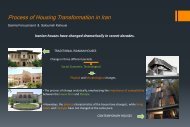Housing Concepts - Oikodomos
Housing Concepts - Oikodomos
Housing Concepts - Oikodomos
You also want an ePaper? Increase the reach of your titles
YUMPU automatically turns print PDFs into web optimized ePapers that Google loves.
OIKODOMOS <strong>Housing</strong> <strong>Concepts</strong><br />
UNIVERSAL DESIGN<br />
”Universal design shouldn’t be a matter of choice, it is a moral necessity”.<br />
The term “universal design” was coined by the late Ronald L. Mace, from the<br />
College of Design, North Carolina State University, USA. In 1988 he defined the<br />
term in the following way:<br />
“Universal design is an approach to design that incorporates products as well as<br />
building features which, to the greatest extent possible, can be used by<br />
everyone. Universal design is a simple concept, but one that requires a<br />
fundamental shift in thinking.<br />
Traditionally, design has catered to averages, creating a world in which few<br />
people can actually thrive. Universal design strives to encompass the widest<br />
possible ranges of size, strength and capability, doing so without the need for<br />
adaptation or specialised design. The intent of universal design is to simplify<br />
life for everyone by making products, communications and the built environment<br />
usable by as many people as possible.”(1)<br />
Thus, as argued above, UD is a design concept that recognizes, respects, values<br />
and attempts to accommodate the broadest possible spectrum of human ability in<br />
the design of all products, environments and information systems. It requires<br />
sensitivity to and knowledge about people of all ages and abilities. Sometimes<br />
referred to as "lifespan design" or "trans-generational design”, UD encompasses<br />
and goes beyond the accessible, adaptable and barrier-free design concepts of the<br />
past. It helps eliminate the need for special features and spaces, which for some<br />
people are often stigmatizing, embarrassing, different looking and usually more<br />
expensive.<br />
Maison à Bordeaux, Rem<br />
Koolhaas ; Best Design<br />
Award of 1998.<br />
This house has the<br />
advantage of being<br />
wheelchair-friendly. It<br />
accommodates technical<br />
facilities for this<br />
purpose and reflects<br />
certain flexibility in<br />
use on its different<br />
levels.<br />
Although this design is<br />
often cited in the<br />
context of universal<br />
design, it is more an<br />
example of design for<br />
special needs; the use<br />
of the platform in<br />
interior space could<br />
create hazardous<br />
situations.






